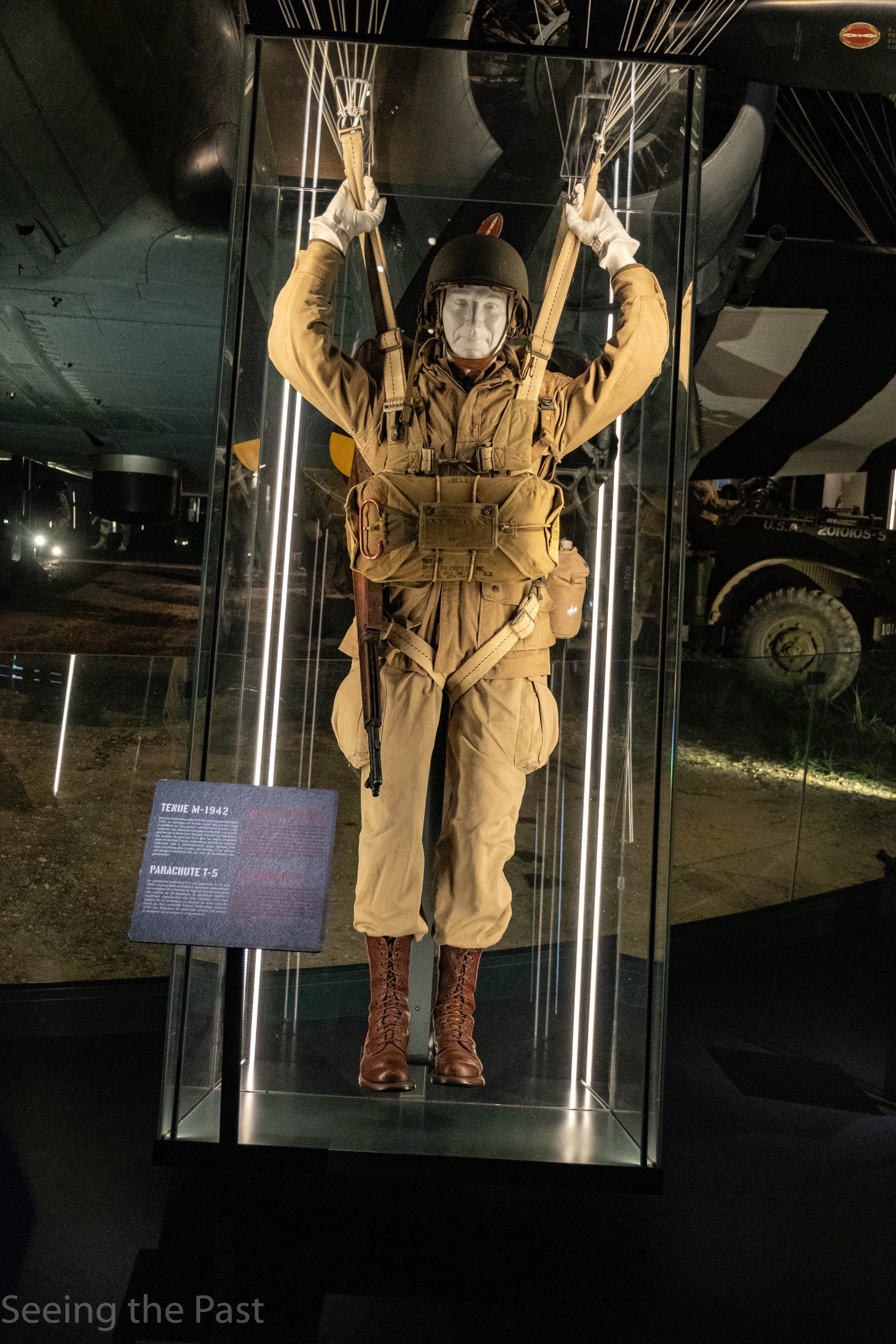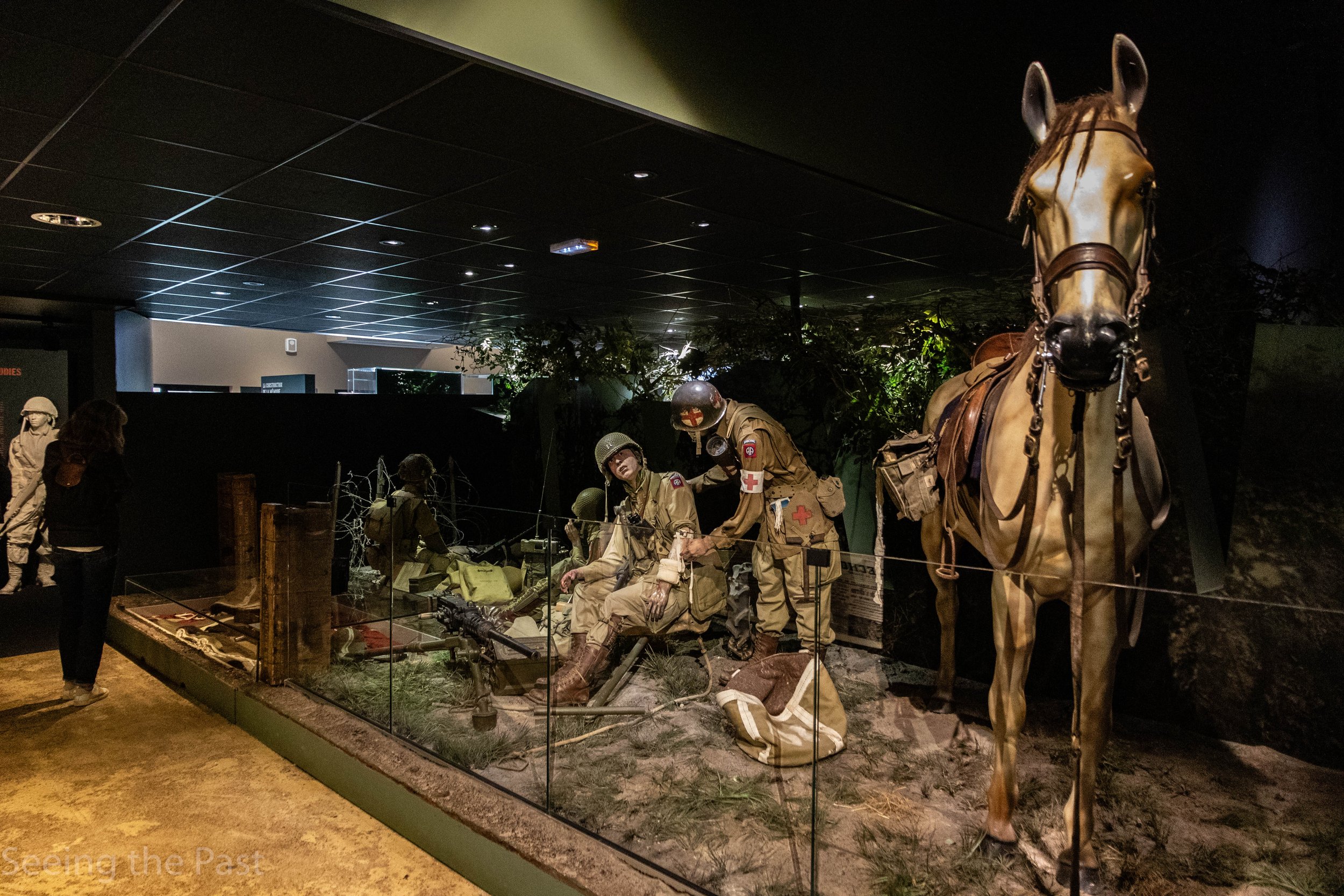The D day Series; Explore the daring World of the paratroopers from the 82nd and 101st Divisions at the awesome St. Mere Eglise's Airborne Museum!"
/To many visitors, especially young people, this museum is nothing short of awesome. It boasts being immersive and the next few photos will give evidence for this boast.
Above and below; go inside a plane that is about to deliver the paratroopers to the drop zone.
Below; it now has you standing at the open door looking down onto the drop zone. You can see fields, hedges and buildings below.
Above; Put a parachute on and look down. The screen below gives you the impression that you are going down to your target.
Above; walk into a paratrooper’s uniform with all of his equipment.
Above; Experience a mission briefing with a hologram.
Above and below for two photos; each visitor is loaned a “Histopad” (tablet) with tons of info and animations relevant to what is being displayed. I enjoyed an animation of John Steele’s descent to his parachute snagging on the church tower.
Above; stepping inside a Dakota with D Day markings on its wings. These were painted so that it was not shot down by friendly fire.
Below; troops getting ready for embarkation.
Above and below; unlike some museums which are just a random collection of artefacts, this museum constantly focuses on all aspects of the Airborne Divisions.
Above and below; there are numerous full size dioramas to engage visitors of all ages.
There are also plenty of artefacts, big and small to look at.
Above; a “Dog tag” belonging to Joseph G Bachulak. These were for the identification of dead or severely injured soldiers.
Below; Nazi badges.
Above; many non Germans were forced to join the Todt Organisation to build “The Atlantic Wall” ie the concrete defences that would prevent a successful invasion, at least in German minds. They had to wear these arm bands.
Above; troop rations, all carefully labelled.
What was the role of US paratroopers of the 82nd and 101st Airborne divisions?
With the D Day seaborne invasion planned for daybreak of the 6th June, there needed to be protection of both the left and right flanks and this was to be done by three airborne divisions just after midnight. Guarding the right flank in the Cotentin Peninsula (as seen from the sea) was the responsibility of the 82nd and 101st, Airborne Divisions, totalling 13,000 troops. The left flank, principally, the area around the Caen Canal and the River Dives, was to be the responsibility of the British 6th Airborne Division. With both flanks secured, it was planned to land by sea 176,475 men together with 1,500 tanks and over 18,000 other vehicles.
The 82nd’s mission was to drop behind enemy lines to block the main road at St Mere Elise preventing German troops coming south from Cherbourg to attack the incoming troops. This was national road 13 (RN 13) which connected the major towns of Caen in the South -East to Cherbourg in the North.
Above; a timeline of the paratroopers from embarkation to landing.
The 101st’s mission was to clear the way for the seaborne assault by seizing the western exits of four roads or “causeways” that crossed marshy areas just inland from Utah Beach. The Germans had flooded this area as part of their defences. Without clear causeways, the soldiers landing at Utah beach would be trapped. They also had to protect the southern flank of the troops arriving at Utah Beach from any German troops moving northwards. To the west of Utah Beach was the River Merderet with two bridges and to the south was the River Douve, with four bridges. All of these needed to be secured although later the Allies destroyed the bridges over the Douve.
The leader of the 82nd mission was Maj. Gen. Matthew B. Ridgway, who, at 49 set a brave example. When he landed in a field, he was in the dark and was all alone. However, he quickly realised he wasn’t alone when a mysterious large object came towards him and so he quickly pulled out his pistol. When he uttered the password,”Thunder”, he didn’t receive any reply but as the figure moved once more, he realised it was only a cow. His response, when he told that story after the war, was, “I could have kissed her”!
When Sgt. Maj. Kenneth "Rock" Merritt landed, he too was all alone, and was unfortunate to land in a thorny patch of brambles! Looking at his parachute he saw 13 bullet holes and realised how lucky he was that everyone of those bullets had missed him. A short time later, a burning Dakota flew 50 feet above his head before crashing a couple of hundred yards away.
Above and below; on display is an account by Kenneth Russell about what happened at the church at St Mere Eglise.
Paratroopers were only lightly equipped for their initial task and so to ensure they were not dominated by heavy fire from the Germans, Gliders were sent in with paratroops with anti-tank guns, small jeeps and heavy machine guns. Please note that “lightly” still meant each paratrooper carried 40kg of equipment
Above and below; a glider with its troops.
Unfortunately, most of the paratroopers did not land at their target and some landed as much as 20km away from their goal. Heavy flak from German anti-aircraft guns broke up the formations with many planes exploding in mid air and several crashing in to the ground with their paratroopers still on board. As a consequence of this, some pilots decided to release their paratroopers early before the dropping zones. Although this reduced their effectiveness it also worked, to a certain extent, in their favour! The troops were so spread out that the defending Germans became so disorientated by hearing American voices everywhere that they overestimated the number of paratroopers and fell back to their original positions! In actual fact, the Germans outnumbered the American forces that had survived the drop!
To help them avoid the enemy and link up with fellow paratroopers, they all carried small brass clickers or "crickets" that they would use to signal each other. One paratrooper would initially signal with a single click and if there was an American paratrooper nearby, he would respond with two clicks. Today, children can buy these at many of the museums to annoy their parents!
For three weeks the 101st Airborne made slow but steady progress in attacking the German held town of Carentan and then were sent back to England to prepare for their next job, “Operation Market garden”. The Airborne troops had been successful, albeit, at a high human cost.
Essential Information.
Getting there.
Getting there;
To get to St Mere Eglise you approach it from the north or south along the N13 and take signs to the village. There are several car parks but use your Sat Nav to take you to one close to the church. There is a fee to park your car.
AIRBORNE MUSEUM
14 rue Eisenhower
50480 Sainte-Mère-Eglise
Tél. 02 33 41 41 35
Fax. 02 33 41 78 8
Opening times and ticket prices
Click here to go to the museum website to get up to date information.








































A day’s wandering around this area of Coventry will present you with hundreds of years of history to discover. You will be able to visit the ruins of the 14th and 15th century church of St Michael that became a cathedral in 1918 as well as the new one next door.. About 160 metres away or a two minute walk, is Holy Trinity church with its amazing Medieval “Doom Painting” which some people believe is the best one in Britain. One minute away, is the wonderful and free Herbert Art Gallery and Museum.